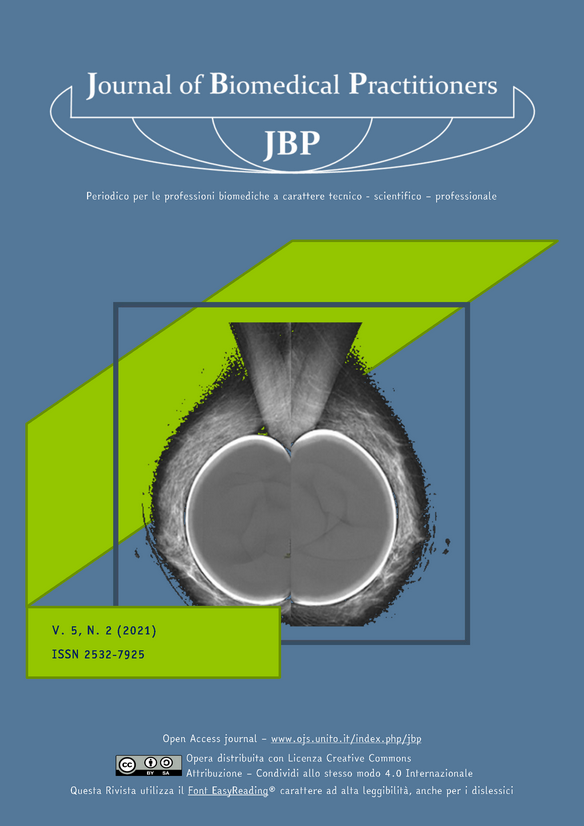Quantitative quality indicators and automated radiotherapy care paths
##plugins.themes.bootstrap3.article.main##
Abstract
INTRODUCTION
High quality standards are often the key for success in modern radiotherapy. The goal of this study is to assess automated and targeted care paths to define new quantitative quality indicators in radiation oncology and optimize the efficiency and safety of the services provided.
MATERIALS AND METHODS
For this study, two international cancer centers part of the same network (UPMC San Pietro in Rome (CC#1) and UPMC Villa Maria in Mirabella Eclano (CC#2)) have been involved, both equipped with a linear accelerator and a CT scan. The data reviewed refers to a period between January 2019 and December 2019. Following the workflow of both centers during electronic medical record data input, we created automated models adaptable to the different types of treatment and customizable for each patient.
Using the ARIA v15 (Varian Medical System, CA, Palo Alto, USA) software, we converted the various steps of the care path in modules that can be connected to create the patient's care process. Care paths are therefore modules of an automated process consisting of tasks and appointments, with well-defined execution times within which they must be completed electronically.
To obtain quantitative information on both centers we focused on three factors: tasks completed in relation to their execution times, number of days, and staff compliance with the automated system.
RESULTS
Measuring the completed tasks allows to define the compliance of the automated process with the care paths, whereas the time required to complete the tasks helps identify areas for improvement. Within this study timeouts are always performed on time, but peer review and treatment approval outcomes are unsatisfactory.
A defined delay time allows to keep track of tasks in a precise manner and reviewing these values in both centers helps us understand if the task delivery time is appropriate or if there is room for improvement. All analyzed data show that the percentage of tasks completed in both centers and the completion times are different.
CONCLUSIONS
Automated care paths and their modules can be an effective and efficient tool to measure the tasks performed by a radiation oncology unit, especially if they are used as a tool of continuous quality improvement.
Downloads
##plugins.themes.bootstrap3.article.details##
Gli autori mantengono i diritti sulla loro opera e cedono alla rivista il diritto di prima pubblicazione dell'opera, contemporaneamente licenziata sotto una Licenza Creative Commons - Attribuzione che permette ad altri di condividere l'opera indicando la paternità intellettuale e la prima pubblicazione su questa rivista.
Riferimenti bibliografici
[2] Eric C. Ford, Ray Gaudette, Lee Myers et al. Evaluation of safety in a radiation oncology setting using failure mode and effects analysis. Int J Radiat Oncol Biol Phys. 2009; 74(3): 852–858.
[3] Maria Jacobs, Liesbeth J Boersma, Rachelle Swart et al. Electronic Health Record implementation in a large aca-demic radiotherapy department: Temporarily disruptions but long-term benefits, International. Int J Med Inform. 2019; (129): 342-348.
[4] The international commission on radiation units and measurements. ICRU REPORT 91: Prescribing, recording, and reporting of stereotactic treatments with small photon beams. Journal of the ICRU. Vol. 14 No. 2. Oxford Uni-versity Press, 2014.
[5] Kelly Cooper Younge, Katherine Woch Naheedy, Joel Wilkinson et al. Improving patient safety and workflow effi-ciency with standardized pretreatment radiation therapist chart reviews. Pract Radiat Oncol. 2017; 7(5): 339-34.
[6] Michael L.George, John Maxey, David Rowlands et al. The Lean Six Sigma Pocket Toolbook: A Quick Reference Guide to Nearly 100 Tools for Improving Process Quality Speed and Complexity. McGraw-Hill, 2005.
[7] D.Lgs. n. 502/1992. Riordino della disciplina in materia sanitaria, a norma dell’articolo 1 della legge 23 ottobre 1992, n. 421 (in Suppl. ordinario alla Gazz. Uff., n. 305, del 30 dicembre 1992).
[8] Istituto Superiore di Sanità. Indicatori generali di valutazione per radioterapia alla luce di un primo audit clini-co. A cura del Gruppo di lavoro Miglioramento Continuo di Qualità in Radioterapia. Rapporti ISTISAN 04/27. III edizione, 42 p. 2004.
[9] M. Saiful Huq, Benedick A Fraass, Peter B Dunscombe et al. A method for evaluating quality assurance needs in radiation therapy. International Journal of Radiation OncologyBiologyPhysics, 2008.
[10] Rex A. Cardan, Elizabeth L. Covington, John B. Fiveash, et al. Using a whiteboard web application for tracking treatment workflow metrics for dosimetrists and physicians. Med Dosim. 2020; 45(1):73-76.
[11] Yasir A. Bahadur, Camelia Constantinescu, Ammar Y. Bahadur, et al. Assessment of performance indicators of a radiotherapy department using an electronic medical record system. Rep Pract Oncol Radiother. 2017; 22(5): 360–367.
[12] R. Alfredo Siochi; Edward C. Pennington; Timothy J. Waldron, et al. Radiation therapy plan checks in a paperless clinic. J Appl Clin Med Phys. 2009; 10(1):43-62
[13] Maurizio Portaluri, Sergio Casciaro, Santa Bambace, et al. Quality assurance in radiotherapy. How to improve the effectiveness and completeness of an electronic patient's chart. Ann Ist Super Sanità 2005;41(4):493-499
[14] Deshan Yang, Yu Wu, Ryan S Brame, et al. Technical note: electronic chart checks in a paperless radiation thera-py clinic. Med Phys. 2012; 39(8):4726-32.

